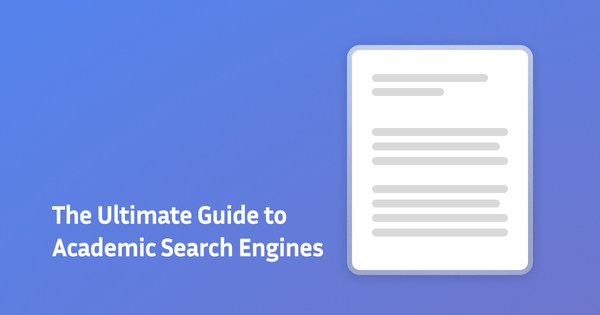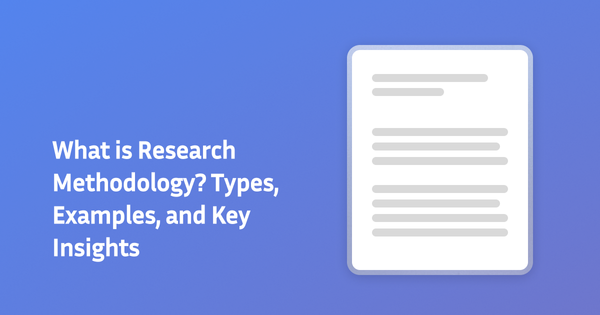Types of Research Methods: Guide to Qualitative & Quantitative Approaches

Embarking on your first research project can feel like standing at the trailhead of an unfamiliar mountain path. You know there's valuable discovery ahead, but which route will lead you to meaningful insights? The answer lies in understanding the different types of research methods available to you.
As a new researcher or academic, choosing the right research method is one of the most crucial decisions you'll make. It shapes how you'll collect data, what kind of information you'll gather, and ultimately, what insights you can generate from your work.
In this guide, we'll walk through the major types of research methods, their strengths and limitations, and how to choose the approach that best fits your research questions.
Research Methodology vs Research Methods: What’s the Difference?
Before diving into specific methods, let's clarify an important distinction that often confuses new researchers:
Research Methodology
Research methodology is the overall approach to the research process.[1] It encompasses the theoretical framework and philosophical assumptions that guide your research strategy. Think of methodology as the broader research philosophy and strategy that informs your entire study.
Methodology addresses questions like:
- What assumptions am I making about how knowledge is created?
- What overall approach will best address my research questions?
- What is the logical structure that will frame my investigation?
For example, choosing a positivist, interpretivist, or critical realist methodology reflects fundamental beliefs about how knowledge is constructed and validated.
Research Methods
Research methods, on the other hand, are the specific techniques and procedures used to collect and analyze data.[1] These are the practical tools you'll employ within your chosen methodology.
Methods answer questions like:
- How exactly will I gather information?
- What instruments or techniques will I use?
- How will I process and analyze the data I collect?
For example, surveys, interviews, experiments, and observation are all specific methods.
Think of it this way: if methodology is the strategic plan for your research journey, methods are the specific vehicles you'll use to travel that path.

Understanding the Research Method Landscape
Research methods fall into three main categories:
- Quantitative methods - focusing on numerical data and statistical analysis
- Qualitative methods - exploring meanings, experiences, and perspectives [2]
- Mixed methods - combining elements of both approaches
Let's explore each of these in greater detail.

What Are Quantitative Research Methods?
Quantitative research methods focus on objective measurements and numerical analysis.[2] They answer questions about "how many," "how much," "how often," or test specific hypotheses through statistical analysis.
Core Features of Quantitative Research
- Objective approach: Emphasizes impartiality and measurement
- Numerical data: Works primarily with numbers and statistics
- Large samples: Often involves larger sample sizes for statistical validity
- Fixed design: Usually follows a predetermined, structured format
- Generalizable results: Findings can often be applied more broadly to similar populations
Examples of Quantitative Research Methods with Use Cases
- Surveys and QuestionnairesSurveys allow researchers to collect standardized data from many respondents, making them ideal for studying trends, attitudes, and behaviors across populations.Example: A researcher develops a 25-question survey to measure study habits among undergraduate students, collecting data from 500 participants and analyzing correlations between study time and academic performance.Best for: Gathering data from large groups, measuring attitudes or behaviors, testing relationships between variablesLimitations: May lack depth; limited ability to explore "why" questions; potential for response bias
- Experimental ResearchExperiments test cause-and-effect relationships by manipulating variables while controlling for others.[4]Example: A researcher tests whether a new teaching method improves learning outcomes by randomly assigning students to either receive the new method or continue with traditional instruction, then comparing test scores between groups.Best for: Testing specific hypotheses, establishing causal relationships, comparing interventionsLimitations: May create artificial settings; ethical considerations may limit what can be tested; expensive and time-consuming
- Correlational ResearchThis approach examines relationships between variables without manipulating them.Example: A researcher investigates the relationship between sleep duration and academic performance by collecting data on both variables from students without changing their sleep patterns.Best for: Exploring relationships when experiments aren't possible, identifying patterns and trendsLimitations: Cannot establish causation; may miss confounding variables
- Quasi-Experimental ResearchSimilar to experimental research but without full random assignment, often used when true experiments aren't practical or ethical.[4]Example: A researcher studies the impact of a new curriculum by comparing schools that implemented it with similar schools that didn't, while controlling for demographic factors.Best for: Real-world settings where random assignment isn't possible, evaluating programs or interventionsLimitations: Weaker causal claims than true experiments; potential for selection bias
What Are Qualitative Research Methods?
While quantitative research gives you the "what" and "how many," qualitative research helps you understand the "why" and "how." These methods explore meanings, experiences, motivations, and perspectives.
Core Features of Qualitative Research
- Subjective focus: Examines personal experiences and viewpoints
- Textual or visual data: Works with words, images, and observations rather than numbers
- Smaller samples: Usually involves fewer participants but with more in-depth engagement
- Flexible design: Often evolves as the research progresses
- Contextual understanding: Provides rich insights about specific situations
Examples of Qualitative Research Methods with Use Case
- In-Depth InterviewsOne-on-one conversations that explore participants' experiences, perspectives, and stories in detail.Example: A researcher conducts 90-minute interviews with 12 first-generation college students to understand the challenges they face in transitioning to university life.Best for: Exploring personal experiences, sensitive topics, complex phenomenaLimitations: Time-consuming; potential for interviewer bias; cannot be easily generalized
- Focus GroupsFacilitated group discussions where participants share and discuss their views on a topic.Example: A researcher brings together groups of 6-8 healthcare providers to discuss barriers to implementing new safety protocols in hospitals.Best for: Generating diverse perspectives, understanding group dynamics, brainstormingLimitations: Group pressure may affect responses; dominant voices may overshadow others
- EthnographyImmersive study of cultures, communities, or organizations through extended observation and participation.[5]Example: A researcher spends six months observing classroom interactions at an elementary school to understand how technology integration affects teaching practices and student engagement.Best for: Understanding cultural contexts, studying behaviors in natural settings, examining social dynamicsLimitations: Very time-intensive; potential for observer bias; challenges in gaining access
- Case StudiesIn-depth examination of a specific instance, situation, individual, or small group.[5]Example: A researcher documents the implementation process of a new healthcare information system at a single hospital, examining challenges and adaptations over 18 months.Best for: Exploring complex processes, unique situations, or novel phenomenaLimitations: Limited generalizability; potential selection bias; resource-intensive
- Content AnalysisSystematic analysis of texts, documents, media, or other materials.Example: A researcher examines policy documents from 20 universities to identify patterns in how they address diversity and inclusion.Best for: Analyzing existing documents, studying media representations, tracking changes over timeLimitations: Limited to available materials; may miss context; interpretation challenges
What Is Mixed Methods Research?
Mixed methods research integrates both quantitative and qualitative approaches, offering a more comprehensive understanding by leveraging the strengths of each.[3]
Types of Mixed Methods Research Designs
- Sequential Explanatory DesignQuantitative data collection and analysis followed by qualitative methods to help explain the quantitative results.Example: A researcher first surveys 300 teachers about burnout levels, then interviews 15 teachers who reported high burnout to understand the underlying factors.
- Sequential Exploratory DesignQualitative exploration followed by quantitative methods to test or generalize initial findings.Example: A researcher conducts focus groups with patients about their healthcare experiences, then develops and distributes a survey based on those insights to a larger patient population.
- Convergent Parallel DesignCollecting and analyzing quantitative and qualitative data simultaneously, then comparing results.Example: A researcher studying the effectiveness of a new teaching approach simultaneously collects test score data (quantitative) and conducts classroom observations (qualitative).
Benefits of Mixed Methods Research
- Provides more comprehensive insights
- Compensates for the limitations of single methods
- Triangulates findings through different data sources
- Addresses more complex research questions
Challenges of Mixed Methods Research
Requires expertise in both quantitative and qualitative approaches
- More time and resource intensive
- May present challenges in integrating different types of data
- Can be complicated to design and implement effectively
New and Advanced Research Methods in 2025
Beyond the traditional approaches, new and specialized methods continue to evolve:
- Action Research: Practitioners investigate their own environments to improve practice, commonly used in education and organizational development.[6]
- Participatory Research: Involves community members as active collaborators rather than passive subjects, emphasizing empowerment and relevance.[6]
- Online and Digital Methods: Specialized approaches for studying digital environments, including digital ethnography, social media analysis, and online surveys.[8]
- Arts-Based Research: Uses artistic expressions (visual art, performance, narrative) as ways of collecting, analyzing, or presenting data.
How to Choose the Right Research Method for Your Project
Selecting the most appropriate research method depends on several key factors:

1. Your Research Question
The nature of your question should guide your methodology: [7]
- "What" or "how many" questions often require quantitative methods
- "Why" or "how" questions typically benefit from qualitative approaches
- Complex questions with multiple facets may call for mixed methods
2. Your Philosophical Orientation
Your beliefs about knowledge and reality influence methodological choices:[7]
- Positivist views (reality is objective and measurable) align with quantitative methods
- Interpretivist perspectives (reality is socially constructed) fit with qualitative methods
- Pragmatist approaches (focus on what works) often embrace mixed methods
3. Practical Considerations
Be realistic about:
- Available time and resources
- Your methodological expertise
- Access to participants or data
- Ethical constraints
4. Field Conventions
Consider the expectations and traditions in your academic discipline:
- Some fields favor certain methodological approaches
- Publication venues may have preferences
- Advisors might have particular expertise
Step-by-Step Research Method Selection Guide
To help you choose the right method for your project, consider these questions:
- What am I fundamentally trying to understand or discover?
- Am I interested in testing relationships, exploring meanings, or both?
- What kind of data would best answer my research questions?
- What methodological approaches are common in my field?
- What are my practical constraints (time, resources, access)?
- What methods align with my own skills and experience?
- What ethical considerations might affect my methodological choices?
Real-World Example: How to Select a Research Method
Let's walk through an example of selecting a research method:
Research Interest: Student engagement in online learning environments
Potential Research Questions:
- Quantitative: "What factors predict student completion rates in online courses?"
- Qualitative: "How do students experience engagement in virtual classrooms?"
- Mixed Methods: "What engagement strategies are most effective in online learning, and why do they work?"
Method Selection Process:
For the mixed methods question, the researcher might choose a sequential explanatory design:
- First collect survey data from 200 students across multiple online courses, measuring engagement levels and identifying the most effective strategies (quantitative)
- Then conduct in-depth interviews with 15 students to understand their experiences with these strategies (qualitative)
- Finally, integrate findings to develop a more comprehensive understanding of effective engagement
Research Method Challenges and Practical Solutions
Challenge: Aligning Methods with Research Questions
Solution: Start with your questions, not your preferred method. If needed, revise your questions or consider mixed methods.
Challenge: Limited Resources or Access
Solution: Scale your approach appropriately. Consider secondary data analysis or focus on more accessible populations.
Challenge: Methodological Expertise Gaps
Solution: Collaborate with colleagues who have complementary skills, seek methodological training, or simplify your approach.
Challenge: Unexpected Data Issues
Solution: Build flexibility into your design when possible. Plan pilot studies to identify potential problems early.
Final Thoughts
As a new researcher, remember that methodology is a means to an end—not the end itself. The goal is to answer your research questions in the most appropriate, ethical, and rigorous way possible.
Start with clarity about what you want to know, then select methods that can best provide those answers. Be willing to learn new approaches, but also realistic about what you can accomplish given your constraints.
With each project, you'll gain confidence in selecting and implementing research methods. Your methodological toolkit will expand, allowing you to address increasingly complex and nuanced questions in your academic journey.
What research questions are you hoping to explore, and which methods might help you find the answers you seek?
References:
- Crotty, M. (1998). The foundations of social research: Meaning and perspective in the research process. SAGE Publications.
- Creswell, J. W. (2014). Research design: Qualitative, quantitative, and mixed methods approaches (4th ed.). SAGE Publications.
- Creswell, J. W., & Plano Clark, V. L. (2017). Designing and conducting mixed methods research (3rd ed.). SAGE Publications.
- Shadish, W. R., Cook, T. D., & Campbell, D. T. (2002). Experimental and quasi-experimental designs for generalized causal inference. Houghton Mifflin.
- Yin, R. K. (2018). Case study research and applications: Design and methods (6th ed.). SAGE Publications.
- Reason, P., & Bradbury, H. (Eds.). (2008). The SAGE handbook of action research: Participative inquiry and practice (2nd ed.). SAGE Publications.
- Bryman, A. (2016). *Social research methods* (5th ed.). Oxford University Press.
- Pink, S., Horst, H., Postill, J., Hjorth, L., Lewis, T., & Tacchi, J. (2015). Digital ethnography: Principles and practice. SAGE Publications.





